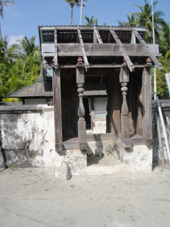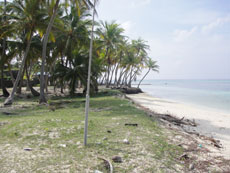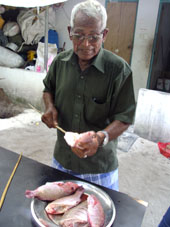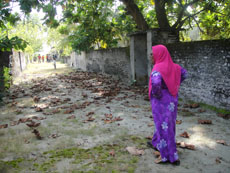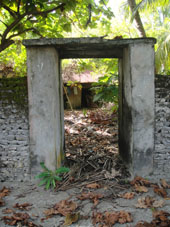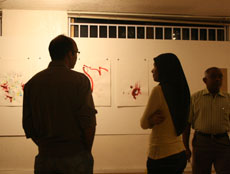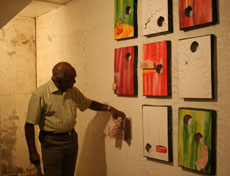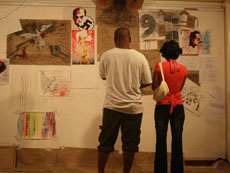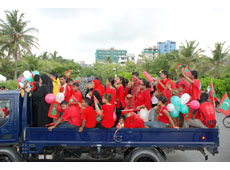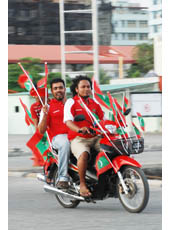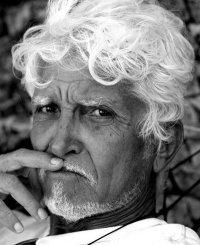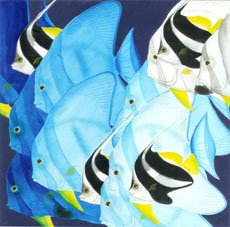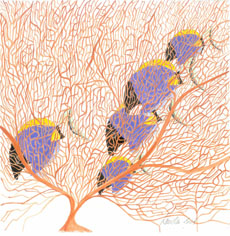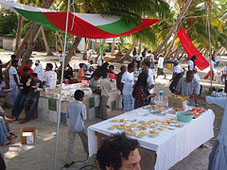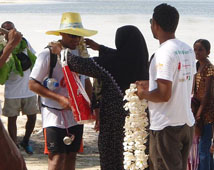Nafiza Abdul Gafoor expertly holds a rock melon in her hands, and shows the technique for cutting it. The 32 year-old has worked in the farming sector for years, and training in Malaysia last year has also made her among the few Maldivians qualified in ‘auto pot’ farming.
‘Auto pot’ is a variation on hydroponics, and was introduced to Maldives through rock melon farming projects carried out by UNDP and Ministry of Fisheries and Agriculture.
“This is a very good method of farming for the Maldives,” says Nafiza. She works as field officer in the four month-old greenhouse in Gnavyiyani Atoll Fuvamulah.
Creating a greenhouse
UNDP and the Ministry of Agriculture invited proposals from interested NGOs in early 2009.
“Our proposal won as we had already found the land and installed the well needed for it,” says Nafiza, who is part of the NGO Society for Environmental Awareness (SEA).
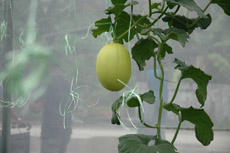
The Malaysian experts assigned to the project did not deem the land as suitable as it was too swampy. Within three months another area of land was procured, and it took the experts ten days to set up the green house and plant the first batch of rock melon plants.
“Now we always maintain 500 plants here,” Nafiza says.
The tedious task of weeding at the onset put off some of those recruited from the eight wards of the island: “Our staff is from nearby three wards now, as the greenhouse is on one end of the island.”
The first six months salary is paid by UNDP. Afterward, seventy per cent of dividends reaped from selling rock melon will be divided among staff with the rest being equally split for marketing, procuring products, and business expansion.
The staff of 32 consists mostly of women apart, with the exception of three men.
Aiminath Waheeda, 42, is a tailor by profession and has her own tailor shop but professeses a fascination for farming.
“My children are grown up now. I have time to do this, and it’s something I’ve always wanted to do,” says Aiminath.
After selling the first batch of melons last month she says she hopes for a better income in the future.
Planting and harvesting
“Within 58 days of planting we can harvest melons,” Nafiza explains.
The melons have to be visually perfect without any marks; this means that Nafiza and the others are careful to avoid walking near the plants once they flower, in case the brushes up against any leaves: “If you touch the plant or even brush up against it after it had flowered, there is the chance of the melon getting marks.”
Special fertilizers are added once a week to the tank that pumps water to the pots through an automated system. This is increased to twice a week once the plant flowers.
“After harvesting the melons we get rid of the plant, and plant the prepared ones the next day.”
Local supplier Happy Market buys melon from them and sells to resorts.
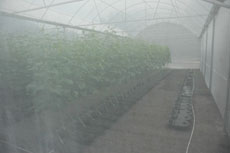
Expansion
“We wanted to introduce a method of farming that would also appeal to the younger generation,” says Dr Aiminath Shafia, state minister for agriculture. Youngsters aren’t keen to toil in the sun, and modern methods such as this could tempt them to farming, she reasons.
The scarcity of land in Maldives and the potential for creating high quality products is another reason for introducing auto pot production methods.
“We have also discussed it with resorts, which are willing to buy the produce if quality and consistency can be guaranteed.” Dr Shafia says linking the greenhouses with resorts is part of the project.
The pilot project carried out in Noonu Atoll Kendhikulhudhoo a couple of years ago proved to be a roaring success and is on the verge of expansion, while in Vaavu Atoll Felidhoo the green house is doing extremely well and another in Baa Atoll Baarah is already selling to nearby resorts.
The next two projects are an island in Addu Atoll and in Thaa Atoll Veymandoo. “We have not done projects in Addu Atoll and there are resorts nearby there, and Veymandoo is a farming island and we have other projects there as well,” Dr Shafia says.
She wants to introduce this method of farming to more people.
“We are willing to carry out little projects of ten pots for a small fee to those who reside in Male,” she says.
 (0)Dislikes
(0)Dislikes (0)
(0)